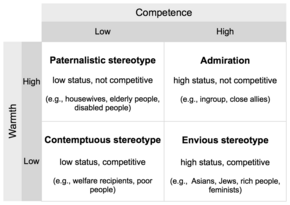Stereotype
[9] The term stereotype comes from the French adjective stéréotype and derives from the Greek words στερεός (stereos), 'firm, solid'[10] and τύπος (typos), 'impression',[11] hence 'solid impression on one or more ideas/theories'.[15][16][19] In this tripartite view of intergroup attitudes, stereotypes reflect expectations and beliefs about the members of groups perceived as different from one's own, prejudice represents the emotional response, and discrimination refers to actions.Finally, communion is associated with connecting with others and fitting in and is similar to warmth from the SCM, with some examples of traits including trustworthy and untrustworthy, cold and warm and repellent and likeable.[20] Modern research asserts that full understanding of stereotypes requires considering them from two complementary perspectives: as shared within a particular culture/subculture and as formed in the mind of an individual person.[20][36] Henri Tajfel[20] described his observations of how some people found that the antisemitic fabricated contents of The Protocols of the Elders of Zion only made sense if Jews have certain characteristics.Therefore, according to Tajfel,[20] Jews were stereotyped as being evil and yearning for world domination to match the antisemitic "facts" as presented in The Protocols of the Elders of Zion.First, the cognitive effects of schematic processing (see schema) make it so that when a member of a group behaves as we expect, the behavior confirms and even strengthens existing stereotypes.[40] For example, in a study by Roguer and Yzerbyt (1999) participants watched a video showing students who were randomly instructed to find arguments either for or against euthanasia.In a second study, subjects rated actual groups – the poor and wealthy, women and men – in the United States in terms of their competence.The correspondence bias was a significant predictor of stereotyping even after controlling for other measures that have been linked to beliefs about low status groups, the just-world fallacy and social dominance orientation.With an experimental vignette study, they analyze how citizens process information on employees' sector affiliation, and integrate non-work role-referencing to test the stereotype confirmation assumption underlying the representativeness heuristic.Research has shown that stereotypes can develop based on a cognitive mechanism known as illusory correlation – an erroneous inference about the relationship between two events.Since both events "blackness" and "undesirable behavior" are distinctive in the sense that they are infrequent, the combination of the two leads observers to overestimate the rate of co-occurrence.[59][62] Lepore and Brown (1997), for instance, noted that the words used in Devine's study were both neutral category labels (e.g., "Blacks") and stereotypic attributes (e.g., "lazy").In a design similar to Devine's, Lepore and Brown primed the category of African-Americans using labels such as "blacks" and "West Indians" and then assessed the differential activation of the associated stereotype in the subsequent impression-formation task.[74] A 2005 study by Terracciano et al. found that stereotypic beliefs about nationality do not reflect the actual personality traits of people from different cultures.In the case of negative feedback, ambiguity has been shown to have a protective effect on self-esteem as it allows people to assign blame to external causes.[83][84] Claude M. Steele and Joshua Aronson conducted the first experiments showing that stereotype threat can depress intellectual performance on standardized tests.Subsequent experiments showed that framing the test as diagnostic of intellectual ability made black students more aware of negative stereotypes about their group, which in turn impaired their performance.[85] Stereotype threat effects have been demonstrated for an array of social groups in many different arenas, including not only academics but also sports,[86] chess[87] and business.[88] Some researchers have suggested that stereotype threat should not be interpreted as a factor in real-life performance gaps, and have raised the possibility of publication bias.[105] A 2005 study by J. Thomas Kellow and Brett D. Jones looked at the effects of self-fulfilling prophecy on African American and Caucasian high school freshman students.For example, in a school when students are confronted with the task of writing a theme, they think in terms of literary associations, often using stereotypes picked up from books, films, and magazines that they have read or viewed.[122] The characters that do appear in movies greatly affect how people worldwide perceive gender relations, race, and cultural communities.Latin Americans are largely depicted as sexualized figures such as the Latino macho or the Latina vixen, gang members, (illegal) immigrants, or entertainers.Some examples are El Bandido, the Halfbreed Harlot, The Male Buffoon, The Female Clown, The Latin Lover, The Dark Lady, The Wise Old Man, and The Poor Peon.Various stereotypic depictions or "types" of women appeared in magazines, including Victorian ideals of femininity, the New Woman, the Gibson Girl, the femme fatale, and the Flapper.These stereotypes give rise to challenges in athletes' lives, including diminished self-esteem, leading to more profound psychological impacts.They have transitioned from being unable to compete competitively due to biological misconceptions to having equal opportunities as male athletes, thanks to Title IX.These social stigmas, including being labeled as gay or delicate, and the expectation to play in a manner deemed "like a girl," have contributed to body image issues, eating disorders, and depression among numerous female athletes.







Stereotype (disambiguation)Stereotypystock characterhandlebar moustachetop-hatsilent filmsmelodramasSnidely WhiplashdoughnutsDiscriminationInstitutionalStructuralStatisticalTaste-basedDialectDisabilityGeneticHair textureHeightLanguageMental disorderRace / EthnicitySkin colorScientific racismSexual orientationSpeciesViewpointArophobiaAcephobiaAdultismAnti-albinismAnti-autismAnti-homelessnessAnti-drug addictsAnti-intellectualismAnti-intersexAnti-left handednessAnti-MasonryAporophobiaAudismBiphobiaClannismElitismEphebiphobiaHealthmentalin povertyFatphobiaGayphobiaGerontophobiaHeterosexismHIV/AIDS stigmaHomophobiaIn-groupLeprosy stigmaLesbophobiaDiscrimination against menMisandryMisogynyNepotismOutgroupPedophobiaPerpetual foreignerPregnancySectarianismSupremacismAryanismAutisticChauvinismFemaleNordicismJewishUltranationalismTransphobia21st-century anti-trans movement in the United KingdomNon-binaryTransmisogynyTrans menVegaphobiaXenophobiaReligiousAtheismCampaigns in ChinaBaháʼí FaithBuddhismChristianityPersecutionCatholicismEastern OrthodoxyJehovah's WitnessesLDS or MormonProtestantismTewahedo Orthodoxypost–Cold War eraFalun GongHinduismUntouchabilityAhmadiyyaShi'ismSufismSunnismminority MuslimJudaismNeopaganismRastafariSikhismYazidismZoroastrianismnationalAfghanAfricanAlbanianArmenianFranceSouth AfricaUnited StatesAssyrianAustralianAustrianAzerbaijaniBlack peopleAfrican AmericansBengaliBulgarianCatalanChechen